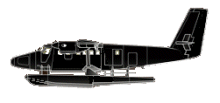
ASN Wikibase Occurrence # 320270
| Date: | Thursday 2 July 2015 |
| Time: | 17:33 |
| Type: |  de Havilland Canada DHC-6 Twin Otter 300 |
| Owner/operator: | Trans Maldivian Airways |
| Registration: | 8Q-MAN |
| MSN: | 435 |
| Year of manufacture: | 1974 |
| Total airframe hrs: | 24123 hours |
| Engine model: | Pratt & Whitney Canada PT6A-27 |
| Fatalities: | Fatalities: 0 / Occupants: 14 |
| Aircraft damage: | Substantial, repaired |
| Category: | Accident |
| Location: | ca 3 km SE off Kuredu Island Resort, Lhaviyani Atoll -
 Maldives Maldives
|
| Phase: | Landing |
| Nature: | Passenger - Scheduled |
| Departure airport: | Komandoo Airport |
| Kuredu Island Resort, Lhaviyani Atoll | |
| Investigating agency: | AICC Maldives |
| Confidence Rating: |
A de Havilland Canada DHC-6 Twin Otter float plane sank off Kuredu Island Resort, Lhaviyani Atoll, Maldives following a landing accident. All 14 occupants survived the accident.
The airplane departed the sea plane base at Male International Airport (MLE) at 16:33 hours local time (11:33 UTC). The aircraft landed at Komandoo at 17:10. Four passengers disembarked at Komandoo and 166 lb of luggage (3 suitcases from the cabin and 1 hand luggage from the aft baggage compartment) were offloaded from the aircraft. The passengers that disembarked at Komandoo were seated in the first and the second row of double seats.
The second sector of the flight was Komandoo-Kuredu with an approximate flight duration of five minutes. The aircraft departed Komandoo at approximately 17:25 and the co-pilot was Pilot Flying on this sector.
The new take-off mass of the aircraft for departure at Komandoo, in accordance with the flight release, was 11,240 lb. 11 passengers (5 female, 4 male and 2 child), 613 lb of luggage and 435 lb of fuel remaining on board.
The take-off at Komandoo was normal as per the crew members. Once airborne, the copilot briefed the captain on the approach and landing area selection. The co-pilot stated that she was taking a North West bound line with Kuredu on the right side of the aircraft. The descent checks were completed shortly after and the aircraft joined the pattern on left downwind. The co-pilot initially requested for 10 degrees of flap followed by 20 degrees of flap on base, with speeds reducing to 75-80 knots. The crew did not recall any anomalies throughout this portion of the flight.
In preparation for the landing, on final approach, the co-pilot requested the flaps at the fully down position and propeller levers forward. Immediately after the selection of flaps, the nose of the aircraft started to rise and the aircraft started to vibrate. The co-pilot stated that she was no longer able to control the aircraft at this stage and transferred the controls to the PIC.
When the captain took over the controls, the aircraft was passing at approximately 300 ft, in a pitch up attitude. The captain stated he saw the stall warning light on and the aircraft was in a right bank going into a spin at this stage.
The captain then applied full left rudder, moved the control column forward and put the power levers to idle. The nose of the aircraft however continued to rise. The captain then moved the flaps to the fully up position. The captain reported gaining a small degree of control at this stage but the aircraft impacted the sea before he could regain full control of the aircraft.
On initial impact the left float detached. The aircraft then bounced and landed on the right float causing the right float to also detach from the aircraft. The right float was, however, trapped between the airframe and the engine for several minutes.
Once the aircraft settled down, the captain gave the command for evacuation. The co-pilot and the cabin crew coordinated the evacuation and all the passengers and crew were able to escape through the left passenger door before the aircraft submerged completely. The captain was the last to leave the aircraft, after making sure that all passengers and other crew had evacuated the aircraft and that everybody had life jackets.
With both floats detached from the aircraft and the right float still trapped, the aircraft stayed afloat until all passengers and crew escaped. At the same time, the aircraft started tilting left causing water to rush inside and started sinking. The aircraft continued sinking, banking left, flipped over then sank to the bottom of the sea. The wreckage was found the next day approximately 3 km southeast of Kuredu Resort at a depth of 36.5 m.
Causes
The investigation identified the following causes;
a. The aircraft was operated outside the centre of gravity limitations on the sector in which the accident occurred.
b. The load distribution errors went undetected because the mass and balance calculations were not carried out in accordance with the approved procedures, prior to the accident flight.
c. The co-pilot (PF) was not alerted to the impending stall as she neither saw the stall warning light illuminated nor heard the aural stall warning.
d. The PIC was not able to gain control of aircraft as developing stall was not recognised and incorrect recovery procedures were applied.
Accident investigation:
 |
|
Sources:
Location
Revision history:
| Date/time | Contributor | Updates |
|---|
The Aviation Safety Network is an exclusive service provided by:


 ©2024 Flight Safety Foundation
©2024 Flight Safety Foundation